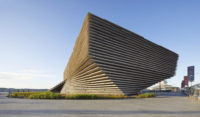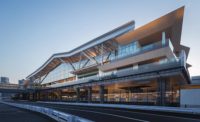In December, Japanese officials announced their selection of Kengo Kuma as the architect for Tokyo’s 2020 Olympic Stadium. Their decision resolved a hotly contested debate over the building’s design and concluded a second competition for its designer after Prime Minister Shinzo Abe scuttled the building’s initial winning design by Zaha Hadid. The controversy continued last month when Hadid refused to sign over her design’s copyright to the Japan Sport Council and sign a gag order.
Kuma’s scheme, which beat out Toyo Ito’s proposal, was lauded for its relatively modest budget and its sensitive architectural expression incorporating live trees and timber construction— one of the architect’s signature elements. The 80,000-seat structure is being developed with Taisei Corporation and Azusa Sekkei Company. Construction is expected to commence as early as December. Kuma spoke to RECORD's correspondent in Tokyo, Naomi Pollock, about the project.
Architectural Record: What does the Olympics 2020 stadium mean to the Japanese people?
Kengo Kuma: The Olympics can be an important event that represents the spirit of the time. Tokyo’s first Olympics, in 1964, symbolized that Japan had caught up with the West. Now people really want a new kind of monument appropriate for Japan’s postindustrial age. Instead of economic expansion, it is a time of quietness and humbleness but also of richness.
When you say “richness,” what do you mean?
Now we are living in a time when energy and resources are very limited. But I believe we can live richly in that kind of severe condition. Japan can be a good model for solving that problem.
Does that mean that this is an energy-conscious project?
Yes. For example, because of funding constraints, the government decided not to air-condition the arena. We carefully designed a louver system that admits wind from the south in the summer and limits it on the north side in winter.
How else are you coping with the tight budget and schedule?
During the competition phase, we began thinking about the construction method. Standardized and not so big, the wood panels and beams will be prefabricated at a conventional factory. Composed of these repetitive elements, the section of the building is the same throughout [making it comparatively easy and quick to build].
Some say there are similarities between your arena and Hadid’s. What do you think?
My idea and philosophy are totally different. For example, Zaha’s seating layout is kind of saddle-shaped, extending up two sides of the building, while we tried to emphasize the horizontality of the building. There are some similarities, since the building code, the site, and the economical span of the concrete are the same, but these are just parts.
Why is wood essential to your scheme?
From ancient times, wood has had a profound impact on the Japanese. Though concrete proliferated in the 20th century, it does not fit with our mentality or lifestyle. The Olympics should be a trigger to go back to wood again. Kenzo Tange’s gymnasium [for the 1964 Olympics] symbolized the age of concrete and is the most beautiful concrete building in Japan. But I am trying to create a monument that is the opposite. We plan to use wood from Japan. Personally, I would like to use wood from Tohoku [the region devastated by an earthquake and tsunami in 2011].
How can Japan balance this costly event with the need for reconstruction in Tohoku?
People in Tohoku are very worried that they will be forgotten, especially since March 11, 2016, marks the disaster’s fifth anniversary, and they are uncertain about the government’s reconstruction policy after that. The Tokyo Olympics can be a magnet that draws attention to Japan. People in Tohoku are trying to reconstruct their villages again as attractive places that can draw tourists and activate the economy. If we design the Olympic facilities carefully, we can support that growth.
What will happen to this building after the Olympics are over?
One of our main ideas is Sora no Mori, meaning “forest in the sky.” It is an 850-meter running track ringing the top of the building and can be used by runners as well as pedestrians. It will be open to the public every day, even if there are events in the arena. The idea of Sora no Mori is that it can draw people to the building and create a new relationship between the stadium and its neighbors.











Post a comment to this article
Report Abusive Comment